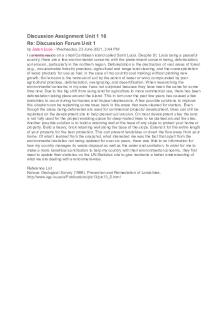UNIT TASK #16 Mounting and Labelling PDF

| Title | UNIT TASK #16 Mounting and Labelling |
|---|---|
| Author | belle naval |
| Course | Histopathology |
| Institution | Our Lady of Fatima University |
| Pages | 1 |
| File Size | 58.9 KB |
| File Type | |
| Total Downloads | 89 |
| Total Views | 141 |
Summary
NA13 MICROTOMT SECTIONIH...
Description
Unit task #16: Mounting and Labelling
Critical Thinking Questions: Answer the following. Submit it on a .docx document. 1.
2.
3. 4. 5.
6.
What is the importance of mounting tissue slides? (2 pts.) - The importance of mounting tissue slides is that essential for preserving the specimen during storage as well as for enhancing imaging quality during microscopy What is the purpose of Sugar and Glycerol in Aqueous Mounting Medium? (3 pts.) - The purpose of Sugar is that increases refractive index and the importance of Glycerol is to prevent drying and cracking. What is the refractive index of Glycerin? ( 1 pt.) - Refractive index of 1.46 What is the refractive index of Farrant’s Medium? (1. pt.) - Refractive Index 1.43 What is the most commonly used Resinous Mounting Medium? Why? (5 pts.) - The most commonly used resinous mounting medium is the DPX Dibutylphthalate Polystyrene Xylene, because of its ability to preserve stains, and dry quickly. Explain the ringing of tissue slides. (3 pts.) - The Ringing is the process of sealing the margins of the coverslip to prevent the escape of fluid or semi-fluid mounts and evaporation of mountant, to fix the coverslip in place, and to prevent sticking of the slides upon storage. - The term “ringing” originated because round coverslips were initially used and the coating applied in the form of a circle or “ring.” A liquid preparation sealed well with nail polish could last some months. - The ringing media used may be Kronig cement made up of two parts paraffin wax mixed with 4-9 parts powdered colophonium resin, heated and filtered. Also available are cellulose adhesives such as Durofix....
Similar Free PDFs

Labelling theory
- 4 Pages

Nutrition 2600 - Food Labelling
- 4 Pages

Econ0002 - Unit 16 Notes
- 19 Pages

Labelling Theory, Lecture 4
- 3 Pages

Unit 8 - Task 1 4566
- 7 Pages

4 Unit 14 - Preparatory Task
- 1 Pages

Unit - Task 2 - Family tree
- 3 Pages

DNA Labelling - Lecture notes 10
- 5 Pages

Unit 9 Task 1 - dsvfd
- 2 Pages

Asking questions - Unit 16 BGB
- 4 Pages

Discussion Assignment Unit 1 16
- 1 Pages
Popular Institutions
- Tinajero National High School - Annex
- Politeknik Caltex Riau
- Yokohama City University
- SGT University
- University of Al-Qadisiyah
- Divine Word College of Vigan
- Techniek College Rotterdam
- Universidade de Santiago
- Universiti Teknologi MARA Cawangan Johor Kampus Pasir Gudang
- Poltekkes Kemenkes Yogyakarta
- Baguio City National High School
- Colegio san marcos
- preparatoria uno
- Centro de Bachillerato Tecnológico Industrial y de Servicios No. 107
- Dalian Maritime University
- Quang Trung Secondary School
- Colegio Tecnológico en Informática
- Corporación Regional de Educación Superior
- Grupo CEDVA
- Dar Al Uloom University
- Centro de Estudios Preuniversitarios de la Universidad Nacional de Ingeniería
- 上智大学
- Aakash International School, Nuna Majara
- San Felipe Neri Catholic School
- Kang Chiao International School - New Taipei City
- Misamis Occidental National High School
- Institución Educativa Escuela Normal Juan Ladrilleros
- Kolehiyo ng Pantukan
- Batanes State College
- Instituto Continental
- Sekolah Menengah Kejuruan Kesehatan Kaltara (Tarakan)
- Colegio de La Inmaculada Concepcion - Cebu




